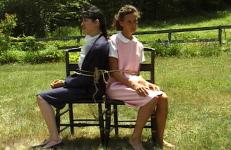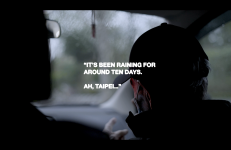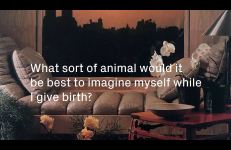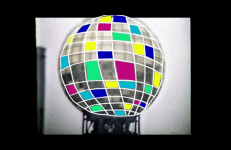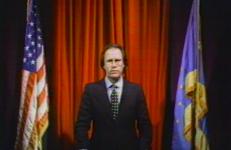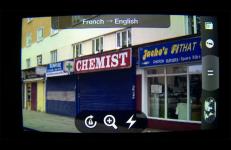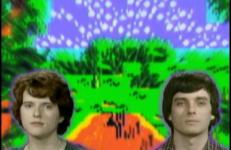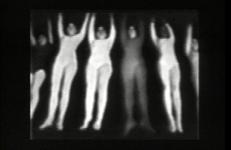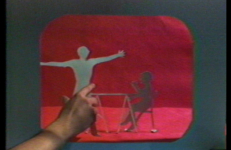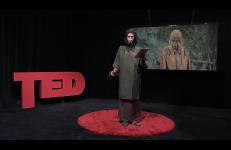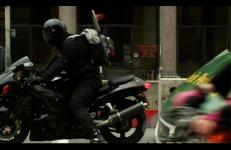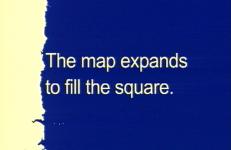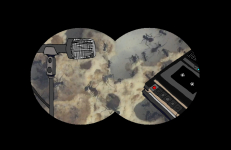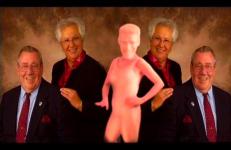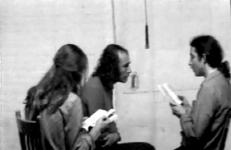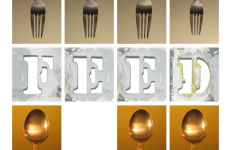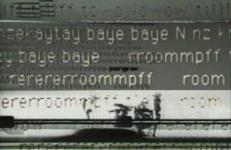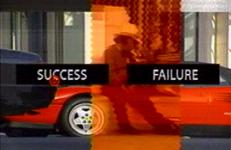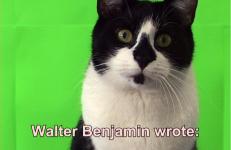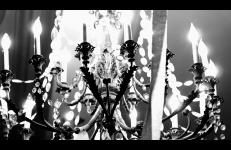Employing the 'case studies' of Helen Keller, Genie the 'wild child' and Angel at My Table author Janet Frame, Goss's extraordinary video contemplates the struggle to be heard, to break free from the prison of the incommunicable self. '[A] tour of the house and grounds of language,' constructed with beguiling visual spaces and surfaces, startling edits, and insinuatingly layered sound design. —New York Video Festival (2000)
Language
Directed by artist and filmmaker Tiffany Sia, The Sojourn imagines a restless landscape film in Taiwan. Visiting scenic locations shot by King Hu, the short experiments with the road movie genre and its intersection with the martial arts epic. Sia meets actor Shih Chun, who played the protagonist in Hu’s Dragon Inn, Touch of Zen and other wuxia films, as he guides the quest to re-encounter the iconic landscapes where Dragon Inn was shot. He counsels on the perfect conditions of mist and weather.
Prompted by Apple’s Siri to ask questions, Magenheimer takes the AI invitation seriously and invents a long list of queries. We see them appear one by one over scanned images from Architectural Digest magazine’s idealized interiors of 1981, the year Magenheimer was born and the year Ronald Reagan became president.
A Song from the Cultural Revolution is a stuttering music video composed of appropriated footage of Bill Gates’s testimony before the U.S. Senate. Gates’s hand gestures have been re-edited, frame-by-frame, into ASCII (American Standard Code for Information Interchange) signs for a text from “Methods of Thinking, Methods of Work,” Quotations from Chairman Mao Tse-tung (New York: Bantam, 1967).
This title is also available on Les LeVeque Videoworks: Volume 1.
The Source is a Hole poses a web of loose connections and liminal associations to sculpt a treatise on transexual mourning. As a series of love letters, stories recount the authors own inception at the 1982 world’s fair, his attempt to remove a lodged tampon, his cravings for bottomless eros, and a barrage of tangential encounters, spanning the everyday, to performance reenactment, to science fiction cinema analysis and drag.
This tape grew out of my fascination with Ronald Reagan and his uncanny ability to demonstrate what I called the 'Signifiers of Americanism'. Through gesture and intonation, he seemed to suggest many of the virtues that Americans hold dear. Although not directly about Reagan, The Speech suggests some of these issues, while remaining purposely ambiguous. The tape is really a speech about speeches.
— Doug Hall
This title is also available on Presidents and Elections.
Filmed directly from the screen of a smartphone using a language translator app that has been told to translate from French into English, Steve Hates Fish interprets the signage and architecture in a busy London shopping street. In an environment overloaded with information, the signs run riot as the confused and restless software does its best to fulfill its task.
After the shrieks and howls of Hymn of Reckoning, I felt that I needed to close out the Oto trilogy with a gentle flashback, to a 1980s sunset beach on a tropical island. The bulk of this video’s work was in animating the speech-bubbles so that they’d blend in with the VHS scene. Playing the scene once and ending the piece felt too fast and fleeting, and I feared that nuances in the conversation would be lost, so I approached it like a verse in a simple, one-part song: I repeated it once again, with just the slightest modifications to its sonic textures.
Based on accounts of girlhood anorexia, Swallow unravels the masked and shifting symptoms that define clinical depression. With a densely layered soundtrack, humorous and painful scenes of potential psychological breakdown reveal a critical loss of meaning, and the failure to diagnose mental illness. Weaving narrative, documentary, and experimental strategies, Swallow intimately traces the awkward steps from unacknowledged depression to self-recognition.
Talk Attacks is a 1983 single-channel video by the artist duo Ligorano Reese. Created during their time in Barcelona, this work delves into themes of miscommunication. Both artists were involved in shooting, editing, and performing in the video, which is characterized by constant changes in scale and size—a technique that connects directly to Ligorano's background in painting and artist books.
Produced by Videografia, Barcelona
Edited by Nora Ligorano & Marshall Reese in collaboration with Remo Balcells
"Fusco revives and embodies the chimpanzee animal psychologist Dr. Zira from the original Planet of the Apes films of the late 1960s and early 1970s. In her Skyped-in introduction, esteemed feminist theorist and technoscience philosopher Donna Haraway explains that Dr. Zira narrowly escaped death in the third film and has been living in hiding, observing human behavior through visual culture. In her lecture, Dr.
In support of experiences that are essentially common, but to which language does not easily adhere, the video passes through places that are both themselves, and stand-ins for others. The title is taken from Aleister Crowley’s 1918 translation of the Tao Te Ching.
Camera, Edit, Sound Design: Deborah Stratman
Music: Eliane Radigue
It is TIME at a street corner in London... A collaboration between filmmaker Roderick Coover and writer Deb Unferth, this short marks the textual disintegration of the speaking clock in an unnerving portrait of technology, power, and the urban environment.
The desire to own and name land and the pleasures of seeing from a distance color this personal survey of the history of mapmaking in the New World. There There Square takes a close look at the gestures of travelers, mapmakers, and saboteurs that determine how we read - and live within - the lines that define the United States.
Threads of Belonging depicts the daily life of Layton House, a fictional therapeutic community, where doctors live with their schizophrenic patients. The characters and events of Layton House were drawn from writings of the anti-psychiatry movement, whose most famous proponent was R.D. Laing. In this film we see experimental therapies, power struggles, and the individual arcs of mental illness converge, as a community struggles to understand itself and determine its destiny.
75 people speak 50 languages sometimes simultaneously.
This title is also available on Sympathetic Vibrations: The Videoworks of Paul Kos.
A film about people trying really hard to listen and people hardly listening.
I'm here to bring you the Truth and the Pleasure
Here to show you the meaningful form
It's going to feel like a new kind of leisure
It's going to smell like a freshly mown lawn
I'm installing a personal toolkit for thinking
Especially customized only for you
You enable it just by the action of blinking
From now on your thoughts will be focused and true
Acconci sits with a man and a woman before a microphone. The man and the woman read from two different texts (novels by Mickey Spillane and Raymond Chandler), and Acconci repeats everything the man says. From time to time, an off-screen voice asks Acconci something about what the woman has been saying, and he tries to answer. The focus of the tape is the relationship between modes of attention, direct and peripheral, in a situation where simultaneous strands of information are being presented.
This title was in the original Castelli-Sonnabend video art collection.
“Many artists developed systems or took on languages to structure their compositions. For this score, Nelson Henricks chose to appropriate English musical notation, which uses letters from A to G to identify the notes of the scale. In combining these letters to make words like CAGE, FACE, DEAD or BED, he simultaneously offers up a semantic and melodic suite. He enriches this double reading with images that clarify or divert the sense(s) of the word. For each tableau, letters appears one after another, creating a rhythm supported by a grid in which colored squares blink on and off.
“Ursonate 1986 is the result of a transference process which utilizes computer and video technology to transport a 1932 phonetic poem, Ursonate, by the German artist Kurt Schwitters into a contemporary context. The poem is recreated by translating the original German phonetics into English for performance by a Macintosh computer. In the early 20th century, Dada artists who experimented with phonetic poetry were exploring the concepts of pre-language and pre-consciousness. The title of Schwitters' piece, Ursonate, translates as a primordial sonata.
Playing off the notion of “interactivity”, Utopia poses itself as a video game plugged into the social consciousness of contemporary California. The viewer/player seemingly makes choices from the menu offering utopian or dystopian realities; however, the score is always the same: the winner loses, and vice-versa. Features Rachel Rosenthal as the host of a macabre interactive game that pushes the boundaries of performance and interactive media.
Playing off the notion of “interactivity”, Utopia poses itself as a video game plugged into the social consciousness of contemporary California. The viewer/player seemingly makes choices from the menu offering utopian or dystopian realities; however, the score is always the same: the winner loses, and vice-versa. Features Rachel Rosenthal as the host of a macabre interactive game that pushes the boundaries of performance and interactive media.
A love letter to the Internet from a feral cat in Brooklyn.
Anonymously published to the web in 2006, Valentine for Perfect Strangers was an early example of an art video that "went viral," amassing over a half-million views and landing on the front page of YouTube.
"A group of students and teachers gather in an historical mansion in the woods of West Virginia for a week-long retreat in spoken Latin. I observe and I participate while navigating the errata with my camera."
— Sky Hopinka




